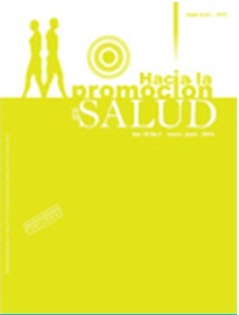Authors
Abstract
Objective: To assess the ICTSs that are being used for education and health information, from the view of the professionals and users of the services and programs of the university welfare unit in two universities in Colombia from August 2012 to June 2013. Material and Methods: A mixed method was used, applying a sequential explanatory design, which included the implementation of questionnaires and interviews, and focus groups to a sample of the professionals and users of the university welfare unit. Results: 78.1% of the professionals widely used traditional technologies: slides, telephone, video and printed material, but there is little use of the new ICTs. The most used are mobile phones (92.2%) and the e-mail to communicate with users and to send them educational messages (69.2%). In everyday life professionals scarcely use these technologies, unlike young users who use mobile phones (100 %) and the Internet to search for information (100%) and socialize through Facebook and Twitter (96.8%). There is an opinion and a positive environment for the integration of the new ICTs, although 100% of the professionals said they have not received training. Conclusions: There was a broad perspective on the most used and recommended ICTs for informative and educational activities in two university welfare units, which reflects what is reported by other studies in terms of the incipient advances in research and ICTs integration in health professionals’ the practice.
References
World Health Organization. National eHealth strategy toolkit [Internet]. 1 ed. Geneve: WHO and International Telecommunication Union; 2012 [actualizado 2012; citado 15 abr 2013]. Disponible en: http://www.itu.int/ITU-D/cyb/app/e-health/NeHSToolkit/form.phtml?file=http://www.itu.int/dms_pub/itu-d/opb/str/D-STR-E_HEALTH.05-2012-PDF-E.pdf
Organización Panamericana de la Salud. Oficina Regional de la Organización Mundial de la Salud. Estrategia y plan de acción sobre eSalud [Internet]. Washington D.C.: OPS/OMS; 2011 [citado 15 abr 2013]. Disponible en: http://www.paho.org/ict4health/index.php?option=com_content&view=article&id=54:estrategia-y-plan-de-accion-sobre-esalud-2012-2017&Itemid=44&lang=es
Gurman T, Rubin S, Roess A. Effectiveness of mHealth behavior change communication interventions in developing countries: A systematic review of the literature. Journal of Health Communication: International Perspectives. 2012; 17(1):82-104.
Katz R, Mesfin T, Barr B. Lessons from a community-based mHealth diabetes self-management program: “it’s not just about the cell phone”. Journal of Health Communication: International Perspectives. 2012; 17(1):67-72.
Chib A, Wilkin H, Xue Ling L, Hoefman B, Van Biejma H. You have an important message! Evaluating the effectiveness of a text message HIV/AIDS campaign in Northwest Uganda. Journal of Health Communication: International Perspectives. 2012; 17(1):146-157.
Uhrig J, Lewis M, Bann C, Harris J, Furberg R, Coomes C, et al. Addressing HIV knowledge, risk reduction, social support, and patient involvement using SMS: results of a proof-of-concept study. Journal of Health Communication: International Perspectives. 2012; 17(1):128-145.
Hernández R, Fernández C, Baptista P. Metodología de la investigación. Distrito Federal de México: McGraw-Hill; 2011.
Valenzuela G, Flores M. El proceso de investigación educativa. En: T. d. Monterrey, editores. Fundamentos de la investigación educativa. Monterrey: Universidad Virtual; 2012. p.12-94.
Cobo JC. El concepto de tecnologías de la información. Benchmarking sobre las definiciones de las TIC en la sociedad del conocimiento. Zer. 2009; 14(27):295-318.
Sociedad para la Promoción y Reconversión Industrial S.A. Guía de autodiagnóstico para pymes en la utilización de las TIC. Bilbao: SPRSA; 2002.
García L. Nivel de conocimiento del personal administrativo y uso de las tecnologías de información y comunicaciones (TIC) en los centros de salud de la ciudad de Piura [Disertación para obtener el título en Ingeniería de Sistemas]. Piura: De la base de datos de la Universidad Católica de los Ángeles Chimbote; 2011.
Herrera-Batista M. Disponibilidad, uso y apropiación de las tecnologías por estudiantes universitarios en México: perspectivas para una incorporación innovadora. Revista Iberoamericana de Educación. 2009; 48(6):1-9.
Litwin M. How to measure survey reliability and validity. London: Sage; 1995.
Lobdell D, Gilboa S, Mendola P, Hesse B. Use of focus groups for the environmental health researcher. Journal of Environmental Health. 2005; 67:36-42.
Gagnon M, Légaré F, Labrecque M, Frémont P, Pluye, P, Gagnon J, et al. Interventions for promoting information and communication technologies adoption in healthcare professionals. Wiley Cochrane Database Syst Rev; 2009.
Llavina X. Facebook: Mejore sus relaciones conociendo la red social que conecta al mundo. Barcelona: Profti editorial; 2011.
Douglas W, Abroms L, Poropatich R, Nielsen P, Wallac, J. Mobile health evaluation methods: the text4baby case study. Journal of Health Communication: International Perspectives. 2012; 17:22-9.
Prensky M. Teaching digital natives. Partnering for real learning. Estados Unidos: Sage; 2010.
Kennedy G, Dalgarno B, Bennett S, Judd T, Gray K, Chang R. Immigrants and natives: Investigating differences between staff and students’ use of technology. Hello! Where are you in the landscape of educational technology? Melbourne: University Melbourne; 2008.
Ministerio de Educación Nacional. República de Colombia. Programa nacional de innovación educativa con uso de TIC. Programa estratégico para la competitividad. Bogotá: Ministerio de Educación; 2008.
Codina L. ¿Web 2.0, Web 3.0 o Web semántica?: El impacto en los sistemas de información de la Web. I Congreso Internacional de Ciberperiodismo y Web 2.0 [Internet]. 2009 [citado 25 agosto 2013]. Disponible en: www.lluiscodina.com/Web20_WebSemantica2009_Nov2009.pdf
Suriá R. Percepción del profesorado sobre su capacitación en el uso de las TIC como instrumento de apoyo para la integración del alumnado con discapacidad. Profesorado. 2011; 15(2):300-14.
Pontifica Universidad Javeriana. Uso y apropiación de TIC en AUSJAL. Un estudio descriptivo [Internet]. 1 ed. Cali: Colombia; 2012. [citado 20 sep 2013]. Disponible en: http://www.ausjal.org/Documentos-Institucionales.html
Fernández A, Oviedo E. Tecnologías de la información y la comunicación en el sector salud: oportunidades y desafíos para reducir inequidades en América Latina y el Caribe. Santiago: CEPAL; 2010.

 PDF (Español)
PDF (Español)
 FLIP
FLIP






















